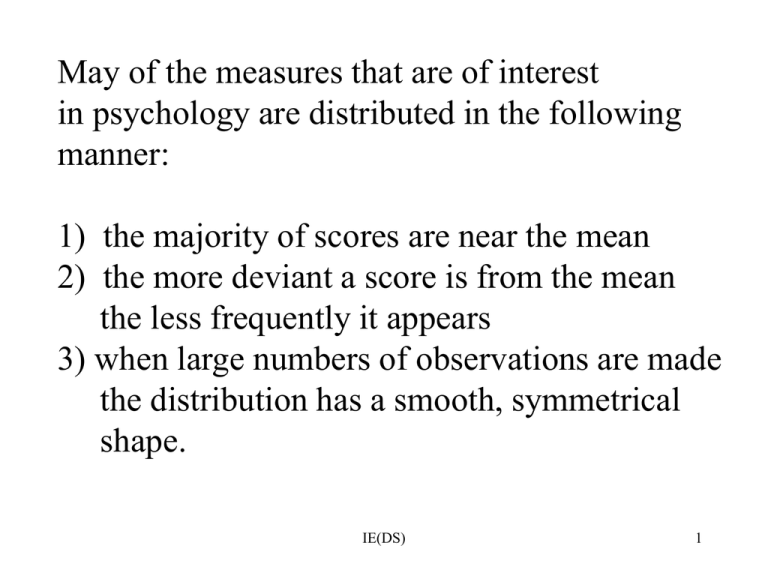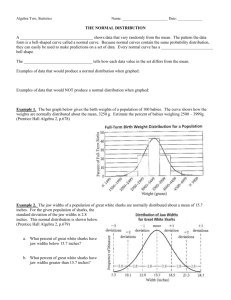Standard Deviation
advertisement

May of the measures that are of interest in psychology are distributed in the following manner: 1) the majority of scores are near the mean 2) the more deviant a score is from the mean the less frequently it appears 3) when large numbers of observations are made the distribution has a smooth, symmetrical shape. IE(DS) 1 Normal Curve or Distribution Standard Deviations Note: this is a frequency Polygon Ordinate = Frequency Abscissa = Standard Deviations IE(DS) 2 Normal Curve or Distribution tails Standard Deviations Note: This curve is Asymptotic Tails never touch the abscissa (there are no ends) Represents idea that no extreme is ever impossible IE(DS) 3 Standard Normal Curve or Distribution Standard Deviations Since there are no ends, we use the Mean of the distribution as the reference point. Mean = 0s IE(DS) 4 Standard Deviation (s) - average distance of the scores in the distribution from the mean. What does the word mean? Deviant - different - the larger s is for a distribution of data the more spread out the data. Standard - Measurement unit - a set amount used to compare other things to. IE(DS) 5 Standard Deviation is a measurement unit we use to assess how different one data score is from the mean of the distribution of observations Example: Height in men X = 5’9” s = 2 John is 5’11” How many s is he from the mean? Pat is 5’9 How many s is he from the mean? Ron is 5’5”? IE(DS) 6 Kate’s height is 2 s from the mean. Bridget’s is - 3 s from the mean. Who is Taller? IE(DS) 7 If you know how many standard deviations you are from the mean you can estimate your percentile rank in the population. 1) Your z score is your number of s from the mean z = (Your score - Mean)/Standard Deviation z Score Mean s IE(DS) 8 Normal Curve or Distribution Standard Deviations We can determine the percentage of scores that fall between the mean and any place on the normal curve. IE(DS) 9 Your Test Score = 84% Class Mean = 74% Standard Deviation = 5 z score = (Score - mean)/ standard deviation Measure of how many standard deviations your score is away from the mean. IE(DS) 10 If the Standard Deviation was 10 what would the z score be? For a normal distribution we can determine the percentage of scores below (or above) any score. IE(DS) 11 Z-scores allow us to compare our standings (percentile position) in two classes. Since the mean and standard deviations of the two classes are not the same, it is very possible that a person could have a higher class standing in a class in which they had a lower test score. In the following example, the mean for each exam is 50, but they differ on their standard deviations. Class A Mean = 50 s = 10 Class B Mean = 50 s=5 z =(60 – 50)/10 = +1.0 z = (60 – 50)/5 = +2.0 IE(DS) 84th percentile 97th percentile 12











